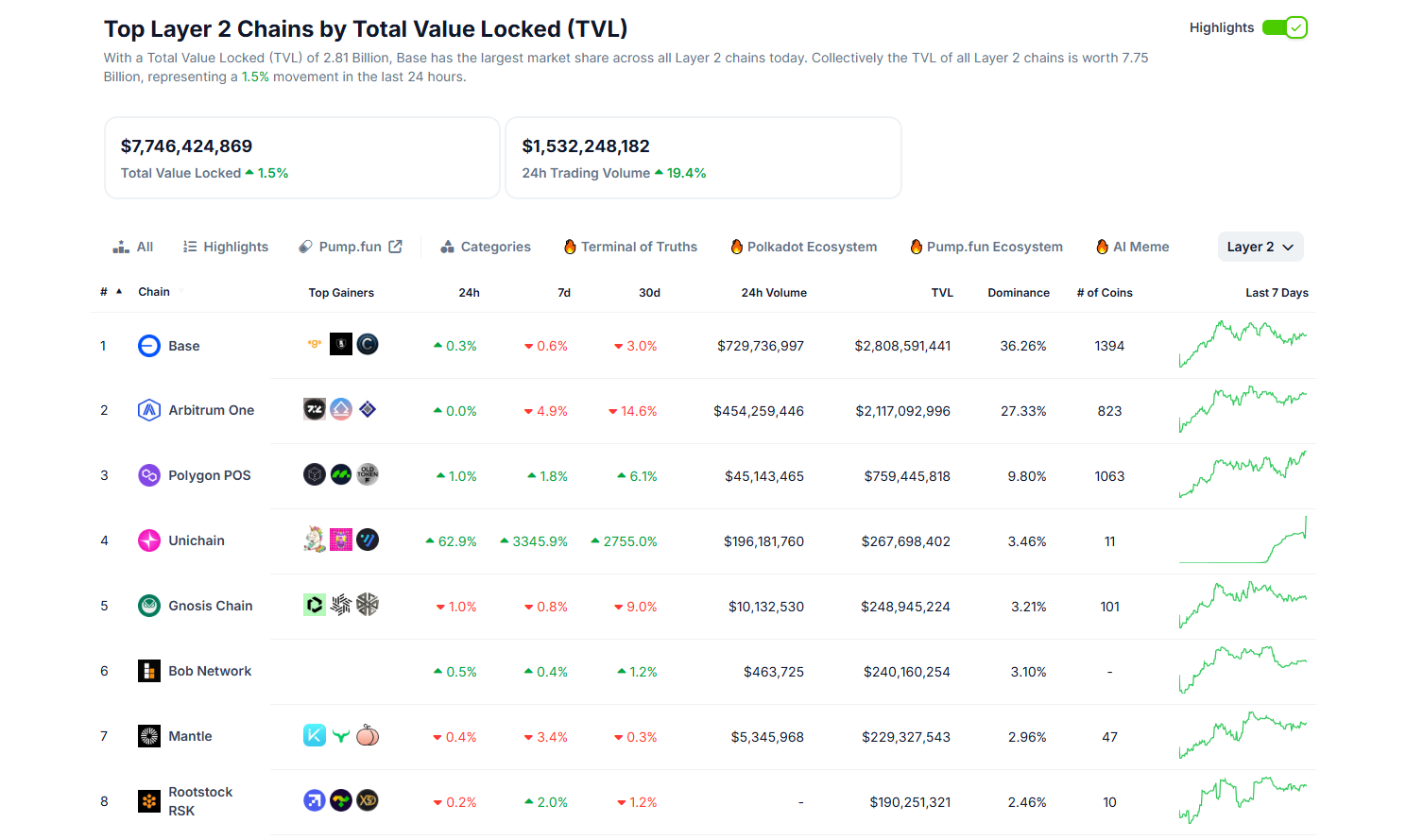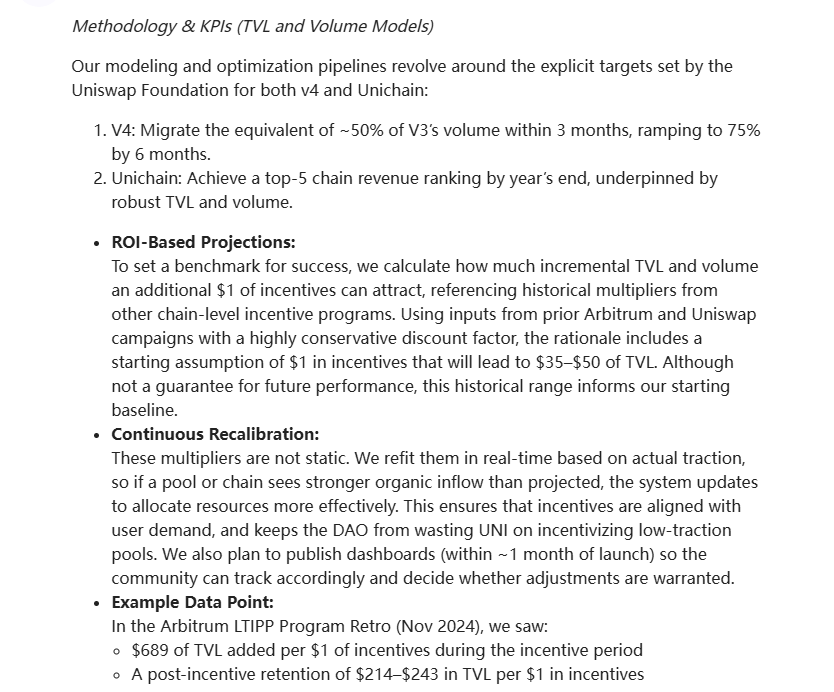Author: Frank, PANews
Since its official launch in February 2025, the Layer2 network Unichain has not immediately made a significant splash in the market, coinciding with an overall adjustment period in the cryptocurrency market, during which its voice was somewhat drowned out.
However, the silence did not last long. On April 15, after Unichain and Gauntlet jointly launched a $5 million liquidity incentive program, Unichain's cross-chain activities significantly heated up. Within just 24 hours, 11 addresses cumulatively injected approximately $22.23 million worth of tokens into Unichain. This sudden "money-splashing" event had an immediate effect. According to DefiLlama data, Unichain's TVL saw an astonishing surge after April 15, skyrocketing from about $9 million to $267 million in just two days. This figure quickly propelled it to the 4th position among many Layer2s. Is this incentive-driven TVL explosion for Unichain merely a brief "money-grabbing" frenzy, or is it an effective validation of Uniswap, the DeFi giant, making a glamorous transition from protocol layer to underlying public chain? Can Unichain seize this opportunity to truly become a new home for DeFi?

L2 Born for DeFi
To understand Unichain's recent explosion, let's revisit its fundamentals. Unichain is the product of Uniswap Labs' years of deep engagement in the DeFi field. It is positioned as a high-speed, decentralized Layer2 solution specifically designed for DeFi and cross-chain liquidity.
In terms of performance, Unichain's performance is similar to other L2s. According to official data, it achieved a block time of 1 second upon mainnet launch and plans to develop TEE (Trusted Execution Environment) technology in collaboration with Flashbots to achieve sub-200 millisecond "sub-second" effective block times in the future, making transactions nearly instantaneous. In terms of cost, Unichain's transaction fees are approximately 95% lower than those on the Ethereum mainnet.
As of April 16, 2025, data from Unichain's official website shows that it has processed over 20 million transactions and has more than 371,000 wallet addresses. Additionally, during the testnet phase, it processed 95 million transactions and deployed 14.7 million smart contracts, reflecting the advantages under the brand effect to some extent.

In terms of ecosystem cooperation, Unichain received significant support from many industry giants at its launch, with nearly 100 crypto projects and infrastructure providers announcing support or building on Unichain, including heavyweight players like Circle, Coinbase, Lido, and Morpho.
Overall, Unichain seems to have gathered the foundational conditions for building a DeFi L2: high performance, low cost, and early support from industry leaders.
How $5 Million in UNI Leveraged $267 Million in TVL
While Unichain's fundamentals are strong, the explosive growth of its TVL was undoubtedly ignited directly by the liquidity incentive program launched by Gauntlet. This program plans to distribute a total of $5 million in UNI tokens as rewards to 12 specific liquidity pools on Unichain over the initial two weeks. These 12 pools mainly focus on mainstream asset pairs, such as USDC/ETH, ETH/WBTC, USDC/WBTC, as well as UNI/ETH and various LST/LRT pairs with ETH.
The intrinsic reasons for this program's effectiveness in attracting liquidity may stem from two aspects.
On one hand, there is the "money-grabbing effect." The $5 million UNI token reward, concentrated in 12 pools and distributed over a short period (initially two weeks), could bring potential high returns for liquidity providers.

We can refer to historical data from Gauntlet's similar incentive programs on other chains to estimate its attractiveness. An analysis from Gauntlet mentioned that based on historical data, a conservative estimate is that $1 in incentives can bring in $35-$50 in TVL. Based on this calculation, this event could ultimately bring about $175 million to $250 million in TVL growth for Unichain. As of the current data, Unichain's performance has already exceeded conventional expectations.

Specifically, how much yield can this program bring? Based on the $267 million TVL growth, users could earn approximately $181 for every $10,000 invested, resulting in a yield of about 1.81%. Of course, this is calculated based on the current level of TVL, and the final TVL may be higher, meaning the actual returns for users could be relatively lower.
On the other hand, behind the large funds chasing this money-grabbing effect, a deeper reason is the demand for "stable returns" during a market downturn. In the first quarter of 2025, the overall cryptocurrency market experienced a correction, with prices of mainstream assets like Bitcoin and Ethereum falling, leading to increased market volatility. In this environment, a large amount of capital, especially large sums, tends to seek relatively low-risk and stable return havens.
As more and more funds flow in, the situation of "many wolves and little meat" exacerbates the competition. Blogger @0x_Todd complained that this mechanism forces LPs to concentrate liquidity in extremely narrow price ranges. For example, USDC/USDT maintains a range between 0.9998-1.0000, resulting in tens of millions of dollars in ultra-high liquidity depth within this narrow range, but due to a fee rate of only 0.01%, daily trading fee income is only $1K-$2K, leading to significant waste of funds.
Overall, the surge in Unichain's TVL is the result of high short-term incentives and the demand for stable returns amid market risk aversion. However, whether this short-term surge has practical significance remains to be seen.
Uniswap's "Sunshine Strategy": Can Unichain and V4 Bring Back DeFi Leadership?
With the mainnet launch of Unichain and the activation of the incentive program, Uniswap Labs' comprehensive layout has also begun to take shape recently. From the deployment of Uniswap V4 to the resolution of regulatory issues, and the advancement of community governance proposals for fee switches, Uniswap seems to be striving to regain its DeFi leadership.

In January of this year, Uniswap V4 was deployed across more than 10 mainstream networks, including Ethereum, Polygon, and Arbitrum. V4 introduced the "Hooks" mechanism, allowing developers to insert custom code at key points in the liquidity pool lifecycle, greatly enhancing the protocol's customizability and transforming it from a DEX into a DeFi developer platform. As of April 17, the TVL of Uniswap V4 has reached $369 million, surpassing that of V2.
Additionally, the prolonged SEC investigation was concluded in February 2025 without any enforcement action against Uniswap Labs, and a settlement of $175,000 was reached with the CFTC regarding specific leveraged token trading. Overall, the systemic regulatory risks facing Uniswap's core business have been significantly reduced.
The push for Unichain and V4 is supported by funding. In March of this year, the "Uniswap Unleashed" proposal was approved, allocating approximately $165.5 million to support the growth of Unichain and V4, including $95.4 million in grants, $25.1 million in operational expenses, and $45 million in liquidity incentives. This funding comes directly from the Uniswap DAO treasury.
The protocol fee switch is undoubtedly one of the core issues of greatest concern to UNI holders. Although the relevant proposal has passed preliminary voting and the final "Uniswap Unleashed" funding vote with a high majority, its implementation still awaits the Uniswap Foundation to resolve related legal entity issues. Once successfully activated, it will directly provide protocol revenue to UNI holders who stake and participate in governance, becoming a key step in capturing the value of the UNI token.
Overall, Unichain appears to be a core, highly optimized "home ground" created by Uniswap, while V4 is the strongest weapon showcased on this battlefield. Ultimately, migrating most of the TVL to Unichain may be a possible long-term goal, but it still seems challenging in the short term. Currently, Unichain's TVL (approximately $178 million) still has a significant gap compared to the Ethereum mainnet (approximately $2.5 billion) and Base (approximately $600 million).
However, Uniswap is likely to continue stimulating the achievement of this ultimate goal through ongoing community incentives. Currently, the Uniswap DAO has approved an initial liquidity incentive of $21 million for Unichain (for a period of 3 months) and expects a total of about $60 million in incentive funding in the first year. Additionally, there is a budget of $95.4 million in grants, part of which will be used for the Unichain ecosystem.
The recent surge in Unichain's TVL, ignited by the liquidity incentive program, is not just a frenzy of capital chasing short-term high returns; it resembles a "firepower reconnaissance" under Uniswap's careful layout. It successfully refocused the market's attention on this L2 network tailored for DeFi and preliminarily validated the feasibility of leveraging strong financial resources to kickstart the ecosystem.
Behind this event lies Uniswap Labs' more profound strategic ambition: by launching Unichain and the V4 protocol, achieve vertical integration from application to infrastructure, creating a high-performance, low-cost, and highly customizable DeFi-exclusive chain to consolidate its leading position in fierce competition. However, whether Unichain can truly transform from "the application chain of the protocol" into "the new home of DeFi" still faces many challenges. Can short-term incentives be converted into long-term user stickiness and genuine ecological prosperity? Can the innovative potential of V4 Hooks be fully unleashed? When will the highly anticipated protocol fee switch finally land, truly empowering the UNI token?
For Uniswap and UNI holders, the future is filled with opportunities and challenges. The success or failure of Unichain will profoundly impact Uniswap's position in the next generation of the DeFi landscape. Whether this glamorous transition from application to chain can succeed is something the market is eagerly watching.
免责声明:本文章仅代表作者个人观点,不代表本平台的立场和观点。本文章仅供信息分享,不构成对任何人的任何投资建议。用户与作者之间的任何争议,与本平台无关。如网页中刊载的文章或图片涉及侵权,请提供相关的权利证明和身份证明发送邮件到support@aicoin.com,本平台相关工作人员将会进行核查。




